Key takeaways:
- Effective outreach involves building trust and empathy, transforming one-way interactions into meaningful conversations with vulnerable individuals.
- Personal connections and adaptability in outreach strategies enhance engagement and foster a sense of belonging within the homeless community.
- Measuring outreach impact should incorporate both quantitative data and qualitative feedback to better understand community needs and refine efforts.
- Follow-up actions and consistent engagement, such as regular meetings or check-ins, significantly strengthen relationships with individuals receiving support.
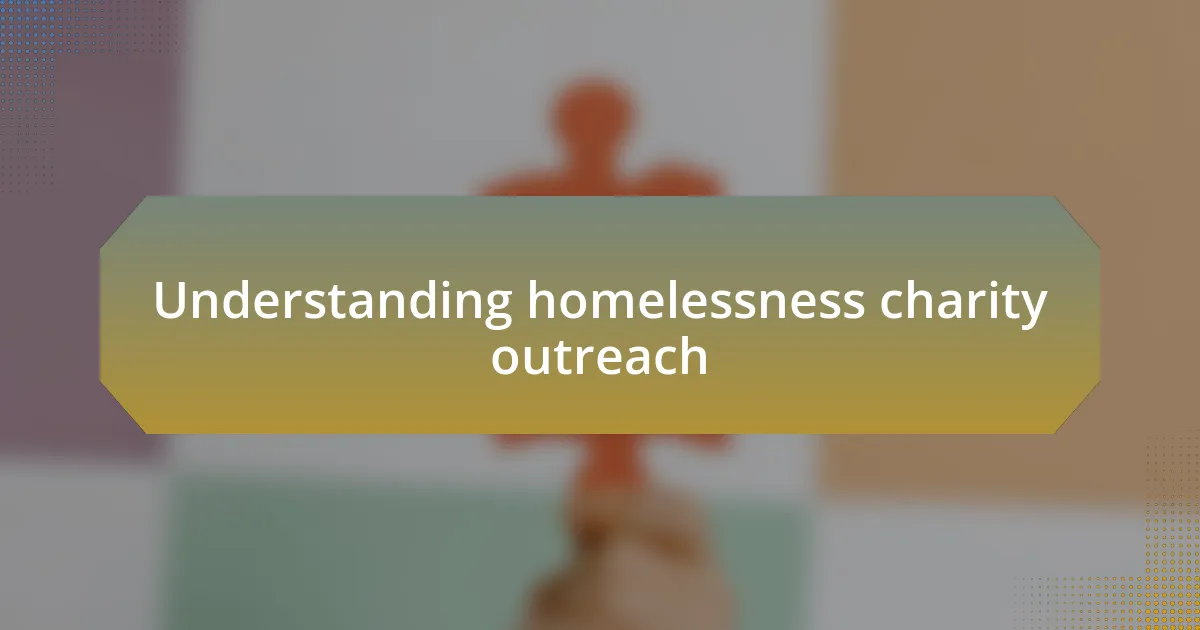
Understanding homelessness charity outreach
Outreach in homelessness charities plays a crucial role in connecting vulnerable individuals with essential services. I remember my first experience volunteering at a local shelter. It was eye-opening to see how a simple conversation could provide someone with the hope they needed to take the next step in their life. How often do we underestimate the power of reaching out?
Effective outreach is not just about distributing resources; it’s about building trust and understanding within the community. I often find myself reflecting on how daunting it must feel for someone experiencing homelessness to approach a charity for help. That’s why it’s vital that outreach workers show empathy, creating an environment where individuals feel safe to share their stories and struggles.
Moreover, the approach we take needs to be tailored to the unique needs of our community. I’ve seen that a one-size-fits-all strategy often falls flat. Engaging with local organizations and truly listening to the stories of those affected can illuminate the best ways to address their needs. What if we made outreach a two-way conversation instead of a simple act of giving? The impact could be transformative.
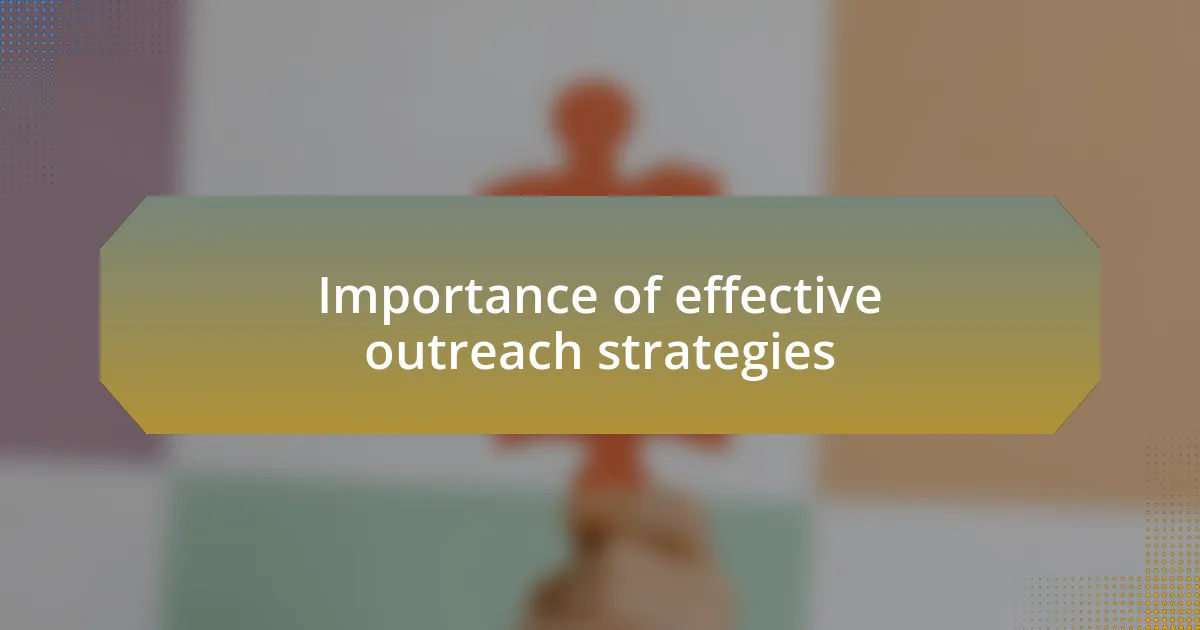
Importance of effective outreach strategies
Effective outreach strategies are essential for ensuring that the right support reaches those in need. During my time volunteering, I often witnessed the magic that happens when outreach efforts are thoughtful and targeted. One winter, we organized a special event to provide warm clothing; it was heartwarming to see individuals walk away not just with items, but with a sense of dignity and connection. Isn’t that what we all crave, a feeling of belonging and care?
Moreover, the importance of effective outreach lies in the empowerment it fosters. I recall a particular instance where a young woman approached our team, hesitant and unsure. After some conversation, she shared her dreams of education and stability. By simply listening and providing her with the right information, we helped pave a path for her future. What if every outreach effort could unlock potential like that? It’s not just about meeting immediate needs; it’s about inspiring hope and resilience.
Additionally, effective outreach enhances a charity’s overall impact within the community. I’ve seen countless organizations flourish after embracing a collaborative outreach model, partnering with local businesses and residents. This synergy not only amplifies resources but enables us to tailor our approaches to what truly resonates with those we serve. How powerful would it be if our outreach transformed into a partnership with the community, rather than a one-sided effort? The possibilities are endless, and the benefits can be life-changing.
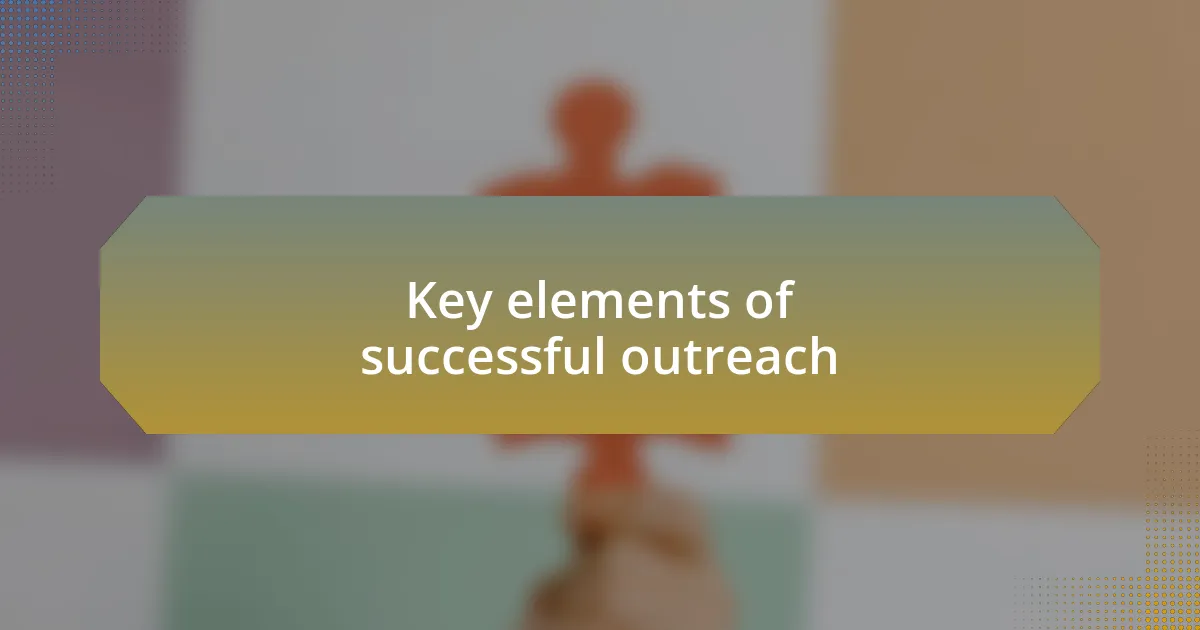
Key elements of successful outreach
Successful outreach hinges on genuine connection and understanding. I remember working with a team that focused on building relationships rather than just delivering services. One of our volunteers took the time to remember names and personal stories, which created trust and a welcoming atmosphere. When our outreach felt personal, we noticed an increase in engagement from those we aimed to help. Isn’t it interesting how a simple personal touch can transform a fleeting interaction into a lasting bond?
Another key element is adaptability. In my experience, no two outreach days are ever the same. One rainy afternoon, we shifted our plan from a park gathering to a local community center. That flexibility allowed us to connect with even more individuals who would have otherwise missed out. How often do we hold onto rigid plans when a little improvisation could lead to greater impact? Embracing change can enhance our outreach significantly.
Lastly, the clarity of communication plays a crucial role. I’ve found that when information is straightforward and relatable, it fosters a better understanding of available resources. Once, during a workshop, we simplified our explanations about housing assistance, using relatable analogies. Attendees were not only more engaged, but they also left feeling empowered to seek help. Isn’t it essential that we ensure our outreach efforts resonate in a way that is both clear and encouraging for those we serve?
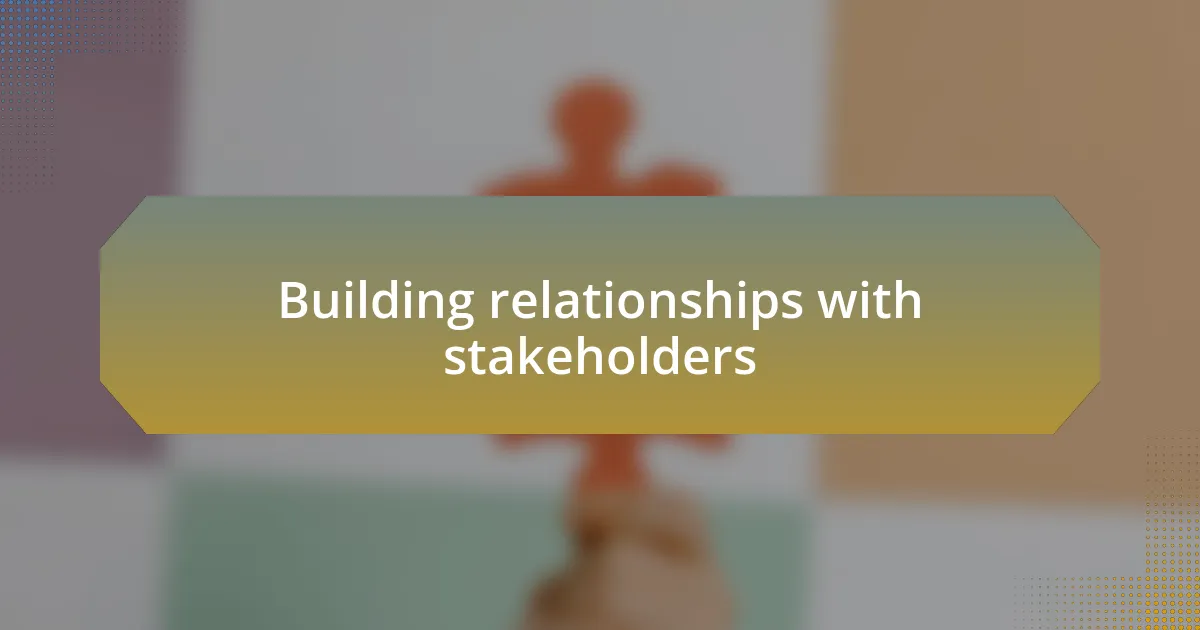
Building relationships with stakeholders
Building relationships with stakeholders is where real progress begins. From my own experience, I once met with a local business owner who was skeptical about collaborating with our charity. By inviting them to join in our community events and share their own stories, I saw a remarkable shift. They started to see our mission not just as charity but as a partnership for change. Have you ever noticed how personal interactions can dispel doubts and open new doors?
Attending stakeholder meetings with a focus on listening rather than speaking has proven invaluable for me. In one meeting, I made it a point to ask about the stakeholders’ passions and concerns. This approach led to an open dialogue where we could explore mutual interests, ultimately forging stronger alliances. Isn’t it fascinating how being genuinely curious can shift the dynamics of a room? I believe this kind of engagement deepens commitment to our shared goals.
Moreover, following up with stakeholders after initial conversations has sparked many fruitful collaborations. I recall a time when I sent a simple thank-you note to a partner after our first meeting. Shortly after, they reached out with ideas for joint initiatives and even provided resources to expand our outreach. Don’t you find that a small gesture can sometimes lead to significant, lasting partnerships? In my journey, I’ve learned that consistent nurturing of these relationships turns interest into action and drives our mission forward.
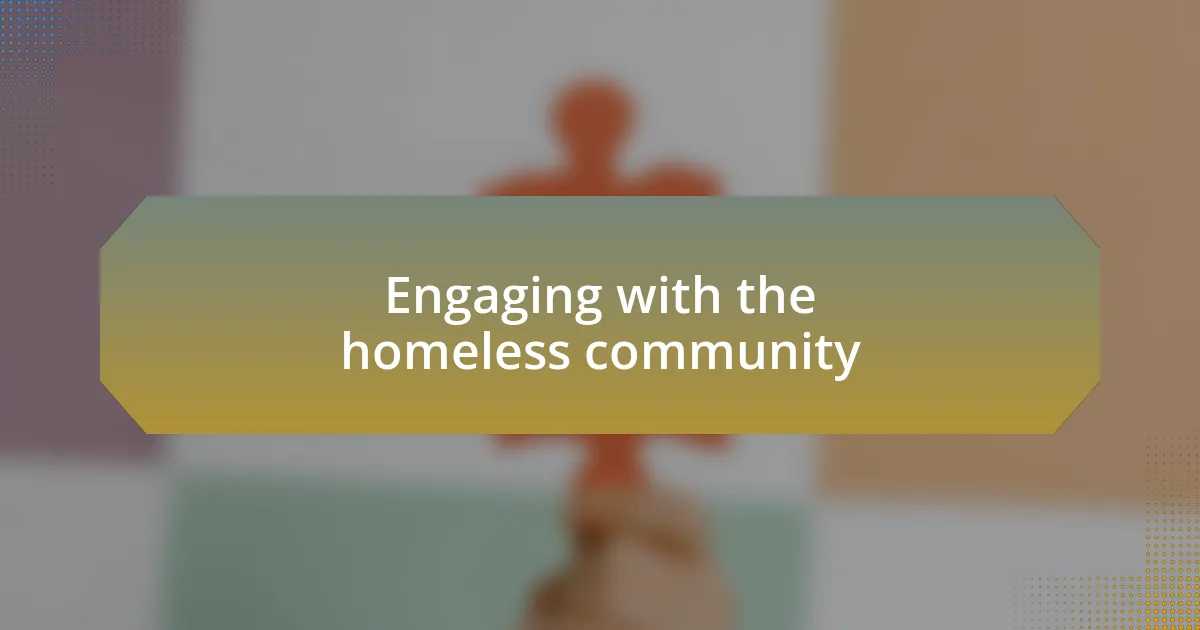
Engaging with the homeless community
When engaging with the homeless community, I believe that showing genuine empathy is crucial. I remember one evening while volunteering at a local shelter, I took the time to sit with a few residents and just listen to their stories. You wouldn’t believe how powerful it was to see the relief on their faces when someone simply acknowledged their experiences. Have you ever felt how a simple act of listening can create a bridge of trust?
Getting involved in community activities is another effective way to connect. During a neighborhood clean-up, I met several individuals experiencing homelessness who actively wanted to participate. By collaborating on a project that benefited the area, we were able to break down barriers and foster a sense of belonging. Have you considered how joint efforts can transform perceptions and strengthen ties?
Furthermore, I’ve learned that consistency in outreach efforts leads to deeper relationships. One winter, I initiated regular coffee mornings, inviting the same group each week to chat over warm drinks. This routine not only built familiarity, but also provided a safe space for them to express their needs. Isn’t it remarkable how reliability can cultivate a supportive community among those who often feel invisible?

Measuring outreach impact and success
Measuring the impact of outreach efforts involves tracking both quantitative and qualitative data. For instance, I remember organizing a small event to distribute care packages. Afterward, we gathered feedback from attendees. Not only did we track how many people showed up, but we also asked them to share their thoughts on what they received. This combination of numbers and personal stories helped us understand our outreach better. Isn’t it fascinating how combining numbers with personal narratives can create a fuller picture?
Another essential aspect is setting clear goals before launching outreach initiatives. I once participated in a project aimed at increasing access to food resources. We established a goal of supporting 50 families over three months. By consistently measuring our progress against this target, we found not only were we able to meet our goal, but we also surpassed it. Reflecting on this, I often wonder how setting specific targets might enhance all outreach efforts.
Lastly, engaging volunteers in the evaluation process can provide invaluable insights. During a volunteer retreat, we reviewed our previous outreach activities, discussing what worked and what didn’t. As we shared our experiences, I realized that those on the front lines had the most vivid perspectives. Isn’t it enlightening how the voices of volunteers can shape the future direction of outreach programs?
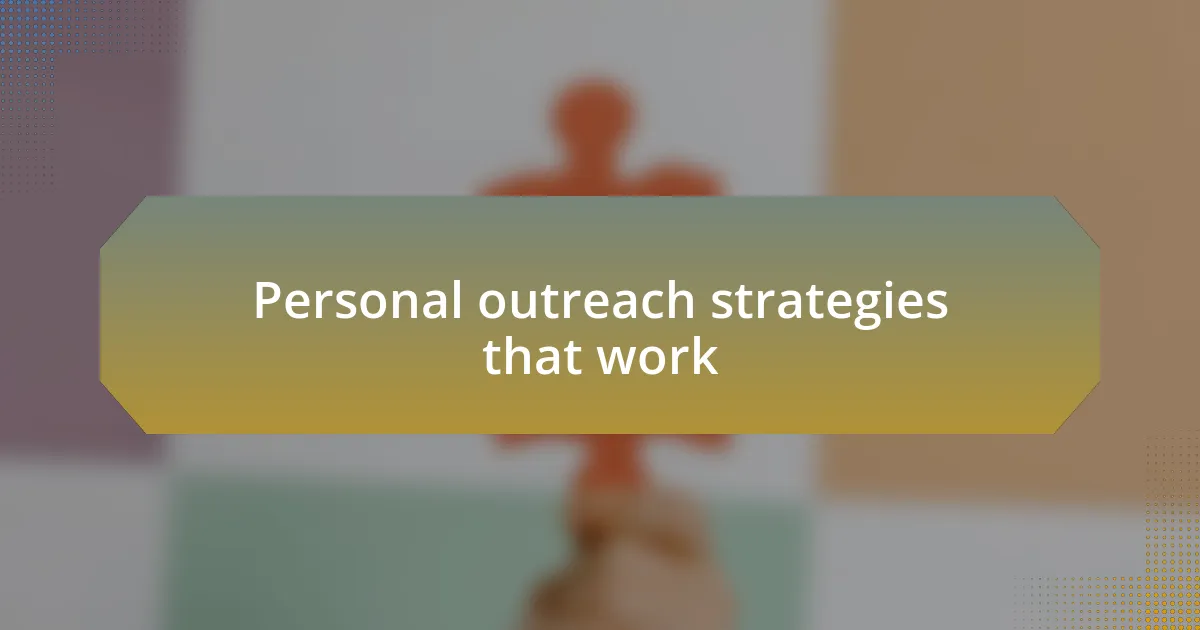
Personal outreach strategies that work
When I engage in personal outreach, I focus on building genuine connections. One memorable experience was when I started visiting a local shelter regularly, not just to hand out supplies but to sit and chat with the residents. Those simple conversations revealed their stories and struggles, deepening my understanding of their needs. Have you ever felt that a small gesture, like listening, can spark a significant change in someone’s day?
In another instance, I organized a neighborhood clean-up day to raise awareness about homelessness in our community. It wasn’t just about the cleanup; it was an opportunity to meet people face-to-face. We shared snacks, stories, and even laughter. This approach turned a simple activity into a building block for community support and collaboration. I believe it’s essential to create activities that promote not only goodwill but also personal interaction; it reminds us that we’re all in this together.
I’ve also found that follow-ups can make a huge difference in outreach effectiveness. After connecting with individuals at an outreach event, I took the initiative to check-in via email or text. One recipient of our services responded with gratitude, sharing how that small gesture made them feel valued and remembered. Isn’t it interesting how something as simple as a message can reinforce a relationship and encourage ongoing support?